17 November, 2003
High Flying Adventure
We set off this morning at 6 AM for our attempted ice flight. Upon
arriving at the U.S. Antarctic Program’s (USAP) Clothing Distribution
Center (CDC), we changed out of our street clothes and into our Extreme
Cold Weather (ECW) gear that must be worn on board the plane in the
event of an emergency landing. Once we were bundled up against the
Antarctic cold, we made our way through the room-temperature USAP air
terminal, reminding ourselves that we would appreciate the warm clothes
once we deplaned in Antarctica (Figure 1). As we watched the safety
video that talked about the upcoming flight and our arrival in
Antarctica, we wondered if our flight would make it today, or be forced
to boomerang back due to bad weather, leaving us to run through this
whole procedure once again tomorrow morning.
Our ice flight team had the distinction of being the first “Herc” flight
of the season. The Hercules LC-130 is a smaller plane used as the summer
season progresses due to its capability of landing with skis on the
permanent ice sheet. The larger C-141 jets must make a wheeled-landing
on the sea ice which starts to break up as the summer season progresses.
So our flight today would be an 8-hour adventure instead of the 5-hour
C-141 flight.
With only a slight drizzle to darken the day, we eagerly filed onto the
Herc, bundled in our ECW gear and toting an enormous sack lunch provided
by the USAP (Figure 2). Our friendly Kiwi pilots ushered us into our
sling seats and helped stow our carry-on luggage into what nooks and
crannies were not already occupied by science supplies and personnel
(Figure 3). Although seating was a bit tight, after take-off we were
free to find space up on the cargo pads where some folks stretched out
for a nap while others played cards or read (Figure 4).
After about 6 hours, we finally had our first sight of the sea ice pack
surrounding Antarctica. For those of us new to this trip, the
announcement of ice meant a rush to one of the few small windows and an
attempt to peer down at the frozen landscape below which was broken up
only by a few open leads which form as the ice pack breaks up for the
summer. It was thrilling to finally see the great white expanse of ice
that you picture when you think of Antarctica. Another half hour brought
us to the edge of the Antarctic continent and I ventured up onto the
flight deck of the plane. My first sight of both a cockpit and the
Antarctic continent was breathtaking (Figures 5 & 6)!
We had finally reached Antarctica! A feat made even more thrilling by
the fact that several flights early in the season had been forced to
turn back due to bad weather at McMurdo Station. We had all dreaded the
thought of flying out for 5 hours, only to return to Christchurch and
try again the next day. We successfully avoided the boomerang and
actually landed in Antarctica. Just as we were ready to set foot on the
sea ice that serves as an airport runway, we discovered that the tail
cargo door had frozen shut during flight. If we exited the front of the
aircraft, the plane might tip back on its tail, making it impossible to
remove the cargo. So we waited patiently in the middle of the Sea Ice
Runway, providing dead-weight until the door could be deiced. Then we
were free.
The long-awaited moment had arrived – we were standing on Antarctica,
Ross Island to be exact. Our exit from the plane was filmed by the
National Geographic crew (Figure 7). Sea Ice Runway is situated near
McMurdo Station, the largest of the USAP stations, and Scott Base, the
New Zealand Station. Ivan the Terra Bus, an enormous transport vehicle
shuttled us to McMurdo Station (Figure 8). One look at the size of the
wheels on vehicles in Antarctica makes and you realize that you are in
an environment like no place else on earth!
After a quick welcome and orientation from the National Science
Foundation (NSF) Station manager, we hurried off to the dining hall for,
ironically, Tex-Mex burritos (a little taste of Texas all the way down
in Antarctica!). Our amazement at the enormity of the dining hall and our
relief at the prospect of a shower and a soft bed quickly turned to
exhaustion. It is time to shutter the windows against the midnight sun
and try to sleep in the twilight of our dorm room. After all, we have a
big day tomorrow at “Happy Camper School.”
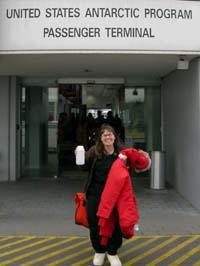
1. Figure 1 - TEA Amy Stoyles from Florida, is dressed in her ECW gear for our ice flight to Antarctica. After being weighed wearing all of her gear, she heads out of the USAP terminal to take the bus to the airstrip. --
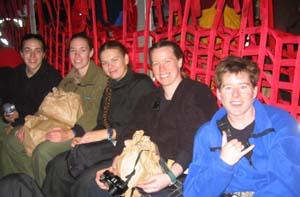
2. Figure 2 - The women of the 2003-2004 Mt. Erebus team squeezed onto a sling seat with our USAP-issued sack lunches. From left to right are Dawn Sweeney, Shauna Mikalich, Julie Calkins, Colleen Brogenski, and Jackie Caplan-Auerbach. --
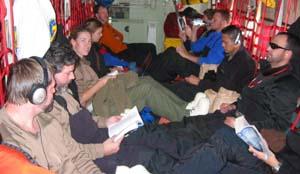
3. Figure 3 - The seating on the Herc flight is tight with passengers packed knee to knee across the aisle, but people quickly make themselves comfortable.
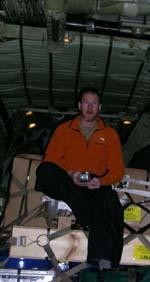
4. Figure 4 - Other people spread out onto the cargo pallets to sleep, play cards, or read. --
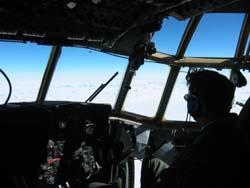
5. Figure 5 - From the flight deck of the Herc our Kiwi pilots have a phenomenal view of the Antarctic continent. --

6. Figure 6 - My first view of the Antarctic continent from the flight deck was breathtaking! --
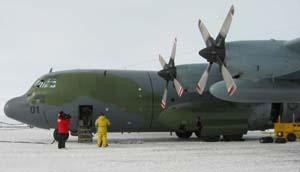
7. Figure 7 - The Hercules C-130 is still able to land on wheels early in the season but will be outfitted with skis for later summer landings. Our arrival was documented by a film crew for a National Geographic special on fieldwork in Antarctica (note the cameraman waiting at the bottom of the steps). --

8. Figure 8 - Upon our arrival at the Willy Field "Ivan the Terra Bus" transported us to McMurdo station. --
Contact the TEA in the field at
.
If you cannot connect through your browser, copy the
TEA's e-mail address in the "To:" line of
your favorite e-mail package.
|
